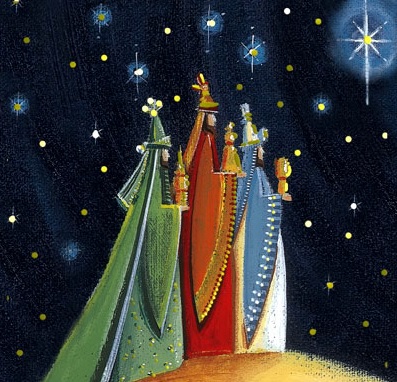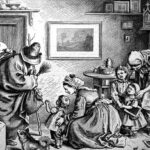On the morning of 6 January, the sound of children’s voices echoes through many German towns and villages. Dressed in crowns and robes, they carry a shining star and sing carols from door to door. They are the Sternsinger – the “Star Singers” – and they bring blessings, chalk-marked doorways, and the joyful conclusion of the Christmas season. Their celebration marks one of the oldest Christian feast days in Europe: Epiphany, also known as the Feast of the Three Kings (Heilige Drei Könige).
While Advent and Christmas may draw more international attention, Epiphany remains a cornerstone of Germany’s winter traditions. It reflects centuries of religious devotion, regional diversity, and enduring cultural meaning. We explore the history, rituals, and significance of Epiphany and the Three Kings in German life – from medieval pilgrimages and royal processions to modern charity campaigns and chalked blessings that still appear on millions of German doorways every year.
The Biblical Origins of Epiphany
The word Epiphany comes from the Greek epiphaneia, meaning “manifestation” or “appearance.” In Christian tradition, it commemorates the visit of the Magi – the Wise Men or Kings – to the infant Jesus. Their journey from the East symbolizes the recognition of Christ by the wider world.
According to the Gospel of Matthew, three wise men followed a star that led them to Bethlehem, where they offered gifts of gold, frankincense, and myrrh. These gifts later came to represent spiritual truths:
• gold for kingship
• frankincense for divinity
• myrrh for mortality
Though the Bible never specifies the number or names of the Magi, Western Christianity developed the tradition of three kings – Caspar, Melchior, and Balthasar – each representing a different continent and age of humankind.
The Arrival of Epiphany in Germany
Christian missionaries brought the celebration of Epiphany to the German-speaking world during the early Middle Ages. By the eighth century, monasteries in Bavaria and along the Rhine were already holding special masses on 6 January. The day quickly became one of the great winter feast days alongside Christmas and Candlemas.
The cult of the Magi received an enormous boost in Germany after 1164, when Emperor Frederick Barbarossa transferred the alleged relics of the Three Kings from Milan to Cologne. The event transformed Cologne Cathedral into one of Europe’s most important pilgrimage sites and permanently anchored the Three Kings in German religious imagination.
The Shrine of the Three Kings in Cologne
To this day, Cologne Cathedral houses the Dreikönigenschrein – the Shrine of the Three Kings. This magnificent golden reliquary, completed around 1225, is considered the largest reliquary in the Western world. Decorated with hundreds of figures, gemstones, and gold panels, it depicts scenes from the lives of the Magi and Christ.
The arrival of the relics in Cologne inspired a wave of devotion across medieval Germany. Towns commissioned paintings, altarpieces, and plays depicting the Kings’ journey. Pilgrims came from all over Europe to venerate the shrine, and Cologne adopted the Three Kings as its patrons – their crowns even appear in the city’s coat of arms.
For centuries, the shrine shaped not just religious life but civic identity. Cologne’s role as the city of the Magi still echoes in its Epiphany celebrations today.
Epiphany as the Twelfth Day of Christmas
In the traditional Christian calendar, Epiphany marks the end of the Zwölfnächte – the Twelve Nights between Christmas and 6 January. In older German folklore, these nights were considered a liminal period when the boundary between the human and spirit worlds thinned. People avoided major tasks, kept lights burning, and watched for omens. Another tradition on this day is baking a Three Kings’ Cake.
Epiphany therefore served as both a spiritual culmination and a ritual of closure. The festival ended the Christmas cycle and opened the door to the new year, both literally and symbolically.
The Sternsinger Tradition: Singing Kings at Every Door
If there is one practice that defines Epiphany in Germany today, it is the Sternsingen – the tradition of the Star Singers. It is one of the most enduring and beloved folk customs in German life.
Who Are the Sternsinger?
The Sternsinger are children, usually between six and fourteen years old, who dress as the Three Kings. They wear simple robes, paper crowns, and sometimes carry incense or a wooden star mounted on a pole. Accompanied by an adult, they go from house to house singing carols and offering blessings in return for donations to charity.
The children write a chalk inscription above each doorway that reads:
20+C+M+B+25
The letters are often thought to represent the names of the Magi – Caspar, Melchior, and Balthasar – but in fact, they stand for the Latin phrase:
Christus Mansionem Benedicat
(“May Christ bless this house”)
The numbers at the beginning and end represent the current year, framing the blessing that protects the home until the next Epiphany.
Origins of the Sternsinger Custom
The practice dates back to medieval Heischebräuche – begging customs performed by children or youths during the Twelve Nights. Over time, these rituals were Christianised and linked to the visit of the Magi. By the 16th century, German towns were recording groups of children visiting homes in early January to perform short plays or sing songs about the Three Kings.
The modern version of the Sternsingeraktion emerged in the 20th century, formalised by the Catholic Church as both a cultural and charitable event.
The Modern Sternsinger Campaign
Since 1959, the Kindermissionswerk (“Children’s Mission Society”) and the German Catholic Youth organisation have coordinated the Aktion Dreikönigssingen, now the world’s largest children’s charity campaign. Every year, over 300,000 children across Germany participate, raising funds for educational and humanitarian projects worldwide.
Their motto changes annually but always centers on solidarity, peace, and the shared responsibility of helping others. The tradition has become both a religious act and a civic event recognised by UNESCO as an Intangible Cultural Heritage of Humanity in 2015.
The Blessing and Its Meaning
The chalk blessing 20+C+M+B+25 carries deep symbolic weight. It is usually written above the front door in white chalk blessed by a priest. Each letter and symbol has meaning:
• 20 and 25 – the year (e.g., 2025)
• + – the Cross of Christ
• C M B – Christus Mansionem Benedicat
Families often leave the blessing in place throughout the year. It serves as both a religious invocation and a sign of community belonging. In many towns, even secular households welcome the Sternsinger, appreciating the charm and goodwill of the tradition.
Epiphany in German Churches
Epiphany remains a major feast day in the Catholic calendar and an important observance for many Protestant communities. Church services on 6 January feature readings from the Gospel of Matthew, hymns about the star, and prayers for peace among nations.
In southern German regions such as Bavaria and Baden-Württemberg, Epiphany is a public holiday. Families attend mass in the morning, after which the Sternsinger may visit homes or appear at parish gatherings. Holy water and incense are often blessed on this day, linking the festival to themes of purification and renewal.
Folk Beliefs and Customs
Beyond church services, Epiphany has inspired a rich tapestry of folk beliefs that intertwine Christian and pre-Christian motifs.
The End of the Raunächte
The night of 5 to 6 January marks the final Raunacht – the mystical Twelve Nights following Christmas. These nights were traditionally filled with superstitions about spirits, omens, and the importance of keeping one’s house in order. Epiphany, with its church blessings and chalked doorways, served to symbolically “seal” the home against misfortune for the coming year.
Water and Incense Blessings
Many Catholic parishes bless Dreikönigswasser (Three Kings’ water) and incense. Families take these home to sprinkle in rooms or barns for protection and good fortune. Farmers once blessed their animals on this day, while homemakers used the water to protect food stores from spoiling.
Bonfires and Processions
In some Alpine areas, Epiphany coincides with the burning of Christmas greenery or small bonfires meant to “chase away” the darkness. Parishes may also hold small processions symbolising the Magi’s journey, sometimes involving children carrying stars through snowy streets.
The Role of Epiphany in the German Christmas Season
For many Germans, 6 January marks the true end of Christmas. It is the day when:
• Christmas decorations are taken down
• nativity scenes are carefully stored
• remaining cookies and baked goods are shared
• children return to school shortly afterward
In some Catholic regions, Epiphany is even called der große Dreikönigstag – the Great Day of the Three Kings – and serves as a symbolic farewell to the festive period.
The Cultural Significance of the Three Kings
The image of the Three Kings has become part of Germany’s visual and moral landscape. They represent not only religious devotion but also unity and diversity.
• Caspar is often shown as a young man of African descent, symbolising Africa.
• Melchior is older and European, representing Europe.
• Balthasar is middle-aged and from Asia.
Together, they embody the universality of faith and the equality of all nations before God. In a modern secular context, they continue to represent generosity, cooperation, and respect for cultural difference.
Proverbs and Sayings About Epiphany
As with many feast days, German folk wisdom surrounds Epiphany with weather lore and agricultural predictions:
“Ist’s an Dreikönig hell und klar, gibt’s ein gutes Weinjahr.”
“If Epiphany is bright and clear, the wine year will be good.”
“Dreikönigssonne bringt viele Wonne.”
“The sun on Epiphany brings much joy.”
These sayings echo the day’s optimistic tone: the sense that light and clarity have returned after the darkness of December.
The Enduring Light of the Three Kings
Epiphany in Germany is a celebration where ancient story, medieval devotion, and modern compassion meet. From the golden shrine in Cologne to the chalked blessings above front doors, the Three Kings remain part of everyday life – symbols of generosity, light, and community spirit.
Their star still shines over Germany each January, guiding not only pilgrims and children but an entire culture that continues to cherish its roots while reaching for new forms of meaning.
Related articles:
Christmas Stories
St. Andreas’ Day
St. Barbara’s Day
St. Lucia’s Day
St. Nicholas Day
St. Martin’s Day (Martinstag) – November 11
St. Thomas’ Day








